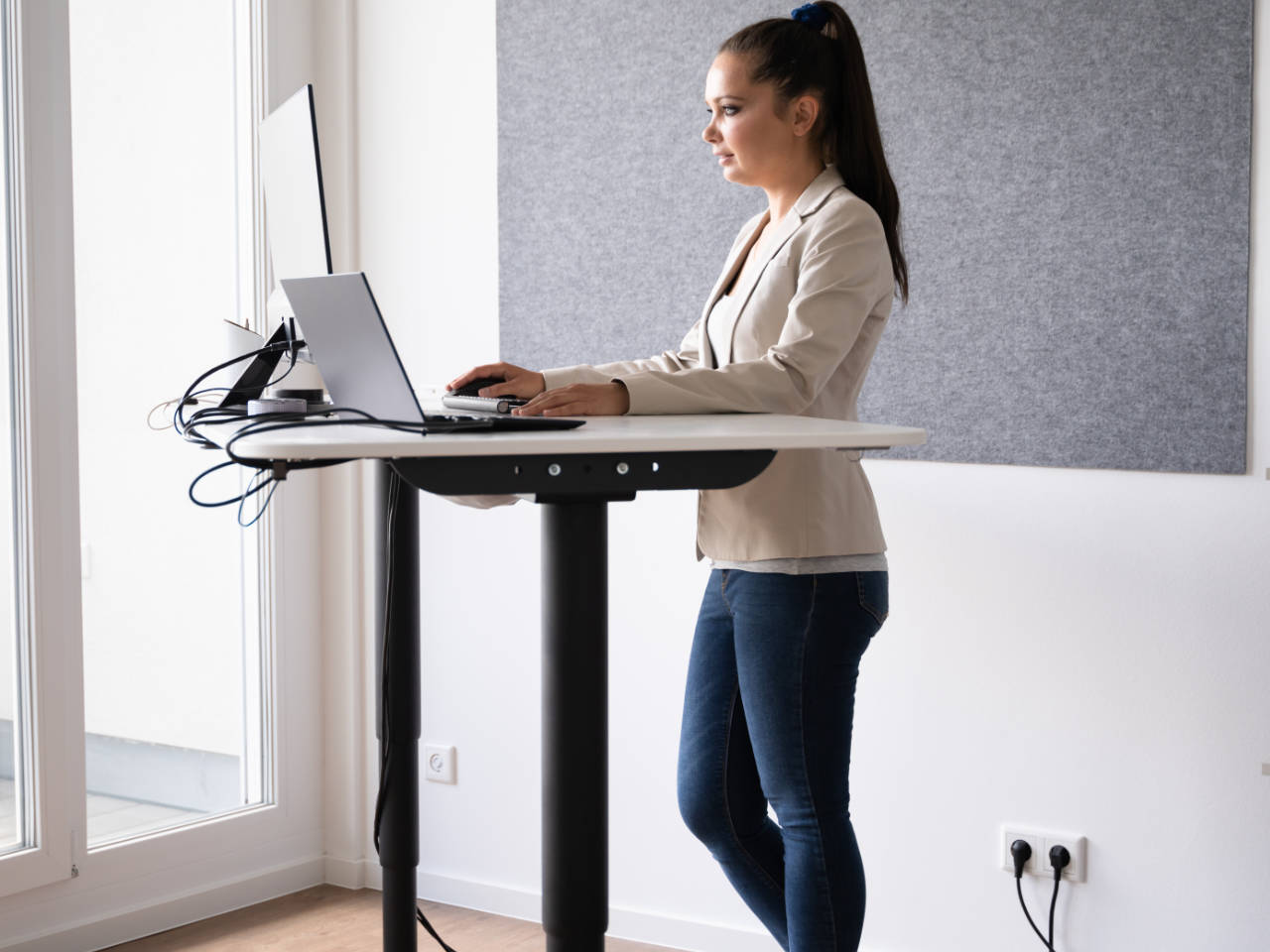
As a sedentary nation, we spend around 67 hours a week seated – equivalent to nearly three full days a week. Many of us are working in office-based roles, and the number of people working from home has risen from 27% in 2019 to 37% since the pandemic, making us more sedentary than ever.
A sit stand desk – also known as a height-adjustable standing desk – can be a helpful alternative to tackle this issue.
What is a sit stand desk?
A sit stand desk is adjustable to different heights and is practical for working while sitting down or standing. It can help combat a sedentary lifestyle caused by work-related sitting and encourage us to move more. A sit stand desk can help reduce discomfort and improve concentration, especially where sitting too long may prove uncomfortable for employees.
Sitting for extended periods can be harmful to our health, so it’s essential to try and incorporate as much movement as possible. It can also be used to ensure employees use DSE equipment correctly by adjusting the desk to help ensure correct arm and screen placement for users. Praxis42’s Display Screen Equipment Training can provide further training for the correct use of DSE equipment.
All employees who regularly use display screen equipment as part of their duties must undergo DSE training. Our Display Screen Equipment (DSE) Training Course helps ensure employees can work safely with display screen equipment, identify risks and know how to avoid problems by using simple ergonomic principles.
Types of sit stand desks you can use
There are various sit stand desks, suitable for different needs and spaces. The three main types are platforms/converters, manual adjustment and electric.
Sit stand platforms and converters
A platform or converter is designed to be placed on the top of an existing desk.
It quickly converts a desk into a standing one without the need to buy a dedicated height-adjustable standing desk. These desks may be a practical alternative for home offices or small rooms. They can be ideal for use in shared desk spaces where users can adjust height settings to individual preferences. If employees regularly work between home and an office, this type can be transported easily.
Manual sit stand desks
To replace a desk with an entirely adjustable sit stand desk, you can opt for one with manual adjustment.
These desks feature a crank on the side that you rotate to regulate the height of the desk. Large in size compared to a platform desk, they are best suited to bigger rooms and offices. They can usually withstand a significant amount of weight, such as several monitors and PC equipment.
Electric sit stand desks
Like a manual sit stand desk, an electric version is usually fully adjustable.
Without the hassle of a manual crank, desk height can be increased at the push of a button. These desks are suitable for coping with additional weight from multiple monitors and books and are easier to lift into the correct position without physical strain. They’re ideal for bigger spaces and employees who require multiple monitors and heavier materials. An electric model may be better for employees with existing injuries or who need additional support, such as during pregnancy or returning to working following surgery or an injury, as it requires no physical adjusting.
What are the benefits of using a sit stand desk?
Sitting for too long and leading a sedentary lifestyle can be harmful to employee health, and the NHS recommends a minimum of 150 minutes of physical exercise each week. A sit stand desk has many benefits including allowing for a more ergonomic set-up and encouraging more movement. The NHS has a guide on how to sit correctly at a desk. It can prevent and tackle some health issues that arise from sitting for too long.
- Reduces discomfort — Back pain can be caused by sedentary lifestyles, so a sit stand desk can help alleviate this by encouraging regular movement.
- Improved concentration and productivity — A sit stand desk can improve employee energy levels. Sitting for extended periods can cause lethargy and tiredness as the body likens it to sleep. Standing up regularly may help boost productivity by waking up the body.
- Improved mental wellbeing — Sitting for hours can result in mental stress caused by a lack of movement. Standing up for phone calls and writing emails may reduce that stress over time.
- Links to prolonging your life — Sitting for too long can affect overall physical health. It has links to obesity, type 2 diabetes and cardiovascular diseases. Standing up and moving helps raise the heart rate and can prevent illnesses.
Tips for using a sit stand desk correctly
Alternate between sitting and standing
While sitting all day is bad for employee health, standing for too long is also not advised. A height-adjustable standing desk needs to be used by alternating between sitting and standing. Standing all day can put pressure on the legs, which may cause swelling and varicose veins.
Adjust the desk and screen
To improve comfort at the desk, setting the desk and computer screen at the correct height and distance is essential. Proper adjustment and placement may help to prevent neck and back strain, as well as eye strain. Praxis42’s DSE training will help advise you on the correct setup for employees to use DSE equipment safely.
Keyboard and mouse position
Working long hours at a desk and using a workstation can put a strain on your arms and wrists. Having the keyboard and desk at a correct angle can help alleviate any wrist strain. Ensure employees are trained on the desired angles and placements of keyboards and the mouse to help prevent injury and provide employees accessories such as wrist rests.
Take regular breaks
Whether standing or sitting, it is recommended that you take regular breaks to prevent discomfort and eye strain. Encourage employees to take regular screen breaks, increasing energy levels and productivity. Arm and wrist stretches may help to prevent Carpal Tunnel Syndrome.
Posture
Good posture while sitting and standing may play a role in preventing strains and aches. Hunching over the desk may lead to back and neck pain and discomfort. It can take a while to get used to sitting or standing with the correct posture, but it may help prevent long-term pains.
Correct chair
To help encourage good posture while sitting down, ensure employees have access to ergonomic chairs. Ensuring the chair is adjustable may help maximise comfort and prevent aches. After a workstation assessment, consider providing employees with additional support, such as lumbar support cushions and foot support.
Small increments
If it’s the first time an employee is using a sit stand desk, it’s worth ensuring that they don’t overdo it. Standing for too long when the body hasn’t adjusted to it will cause unnecessary pressure on the legs and back. Standing and sitting in small increments will give the body the time to adapt. Increasing these increments slowly can result in becoming more comfortable when standing for longer.
Ensure your organisation complies with the Display Screen Equipment Regulations 1992 with our Display Screen Equipment (DSE) training. Fully IOSH Approved, CPD Certified and SCORM Compliant training.
Download our free workstation assessment+ guide for additional guidance.

Adam Clarke
Managing Director (Consulting)
